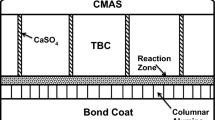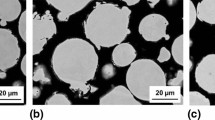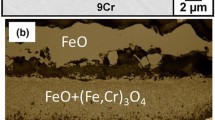Abstract
When metals and alloys are used at high temperatures, especially in combustion processes, deposits often accumulate on the metal surfaces and affect the oxidation processes. This paper is concerned with deposit-induced accelerated corrosion, or hot corrosion, of metals and alloys. Initially, the characteristics of hot corrosion are identified for Na2SO4 deposits in terms of the factors that influence the reaction process. It is shown that hot corrosion consists of initiation or incubation and propagation stages. During the initiation or incubation stage, the deposit is shown to not have a significant effect on the corrosion processes, but it is causing conditions to develop whereby the propagation stage characteristics are determined with attendant large increases in the corrosion rates. Type I, high temperature hot corrosion and Type II, low temperature hot corrosion are then described in terms of historical mechanistic perspectives. The dependence of Type I and Type II hot corrosion on temperature and SO3 partial pressure is discussed along with future work that is needed in order to more completely understand these hot corrosion processes along with the effects of some elements such as Cr, Al, Mo, Co and Pt.

























Similar content being viewed by others
Notes
All compositions are in weight percent unless stated otherwise.
References
J. Stringer, Annual Review of Materials Research 7, 477 (1976).
Y. S. Zhang and R. A. Rapp, Journal of Metals 46, 47 (1994).
F. S. Pettit and C. S. Giggins, in Superalloys II, eds. C. T. Sims, N. S. Stoloff, and W. C. Hagel (John Wiley and Sons, New York, NY, 1987).
P. Hancock, Corrosion of Alloys at High Temperatures in Atmospheres Consisting of Fuel Combustion Products and Associated Impurities, (Her Majesty’s Printing Office, London, 1968).
K.-Y. Jung, F. S. Pettit, and G. H. Meier, Materials Science Forum 595–598, 805 (2008).
N. S. Bornstein and M. A. DeCrescente, Transactions of the Metallurgical Society of AIME 245, 1947 (1969).
L. F. Aprigliano, Burner Rig Simulation of Low Temperature Hot Corrosion. David W. Taylor Naval Ship Research and Development Center, Report MAT-77-68, November, 1977.
W. T. Reid, External Corrosion and Deposits in Boilers and Gas Turbines, (Elsevier, New York, 1971).
A. U. Seybolt, Transactions of the Metallurgical Society of AIME 242, 1955 (1968).
N. S. Bornstein and M. A. DeCrescente, Metallurgical Transactions 2, 2875 (1971).
R. A. Rapp and K. S. Goto, in Molten Salts, eds. J. Braunstein and J. R. Selman (The Electrochemical Society, 9, Pennington, NJ, 1981), p. 81.
Y. S. Zhang and R. A. Rapp, Corrosion 43, 348 (1987).
J. A. Goebel and F. S. Pettit, Metallurgical Transactions 1, 1943 (1970).
N. Otsuka and R. A. Rapp, Journal of the Electrochemical Society 137, 46 (1990).
A. K. Mishra, Journal of the Electrochemical Society 133, 1038 (1986).
K. P. Lillerud and P. Kofstad, Oxidation of Metals 21, 233 (1984).
P. Kofstad and G. Akesson, Oxidation of Metals 14, 301 (1980).
K. L. Luthra, Metallurgical Transactions, 13A, 1982, 1647 and 1843.
R. H. Barkalow and F. S.Pettit, On the oxidation mechanisms for hot corrosion of CoCrAlY coatings in marine gas turbines. Proceedings of the 14th Conference on Gas Turbine Materials in a Marine Environment (Naval Sea Systems Command, Annapolis, MD, 1979), p. 493.
K. T. Chiang, F. S. Pettit, and G. H. Meier, in High Temperature Corrosion, NACE-6, ed. R. A. Rapp (National Association of Corrosion Engineers, Houston, TX, 1983), p. 519.
J. Schaeffer, G. M. Kim, G. H. Meier, and F. S. Pettit, in The Role of Active Elements in the Oxidation Behavior of High Temperature Metals and Alloys, ed. E. Lang (Elsevier, London, 1989), p. 231.
Acknowledgments
G. H. Meier and B. Gleeson are thanked for helpful discussions and assistance in preparing this paper. The Office of Naval Research (ONR) is gratefully acknowledged for support in preparing this paper as well as for many research efforts dealing with hot corrosion attack.
Author information
Authors and Affiliations
Corresponding author
Rights and permissions
About this article
Cite this article
Pettit, F. Hot Corrosion of Metals and Alloys. Oxid Met 76, 1–21 (2011). https://doi.org/10.1007/s11085-011-9254-6
Received:
Revised:
Published:
Issue Date:
DOI: https://doi.org/10.1007/s11085-011-9254-6




